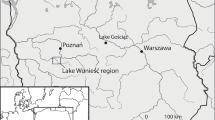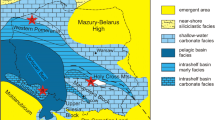Abstract
The construction of the Rideau Canal was one of the greatest engineering accomplishments of the nineteenth century, creating a navigable waterway linking the Ottawa River with Lake Ontario. Colonel By Lake, located at the southern end of the canal near Kingston Mills, was created by the damming of the lower Cataraqui River. The canal flooding in 1831 raised water levels by almost 8 m, inundating former wetlands and lowland areas. European settlement in the pre-canal-era (ca. 1780s) was associated with widespread deforestation and limited flooding of wetlands by construction of mill dams. A detailed sediment coring program was conducted in Colonel By Lake to reconstruct the pre-canal environment and to document water level and land-use changes associated with European settlement and canal construction. The paleoenvironmental record was obtained through analysis of multiple environmental indicators including sediment facies, particle size, magnetic susceptibility and downcore changes in testate amoebae (thecamoebian) diversity. The core lithostratigraphy consists of organic-rich muds overlying peaty gyttja and a lowermost unit of fine to coarse silts. The canal flooding surface (ca. 1831) is clearly defined by a shift to finer grain sizes and increased magnetic susceptibility within the upper 40–60 cm. The shift is associated with an overall increase in thecamoebian abundance and diversity, and high numbers of Difflugia oblonga and Cucurbitella tricuspis that indicate a shift to a deeper and more eutrophic environment. In contrast, the pre-canal environment has lower thecamoebian abundance with assemblages characteristic of marsh environments (Centropyxis constricta, Centropyxis aculeata). The onset of canal flooding (ca. 1790s) is identified by an increase in Pontigulasia compressa (~50 cm), recording a higher water flow rate. The study shows that a multi-proxy paleoenvironmental approach can clearly define different environmental changes due to land-use changes during colonisation and canal-era construction activities.








Similar content being viewed by others
References
Burbidge SM, Schröder-Adams CJ (1998) Thecamoebians in lake Winnipeg: a tool for Holocene paleolimnology. J Paleolimnol 19:309–328. doi:10.1023/A:1007942301638
Christie CE, Smol JP (1996) Limnological effects of 19th century canal construction and other disturbances on the trophic state history of upper Rideau Lake, Ontario. Lake Reserv Manag 12:448–454
Clark C (2004) Sediment magnetic record of post-colonial environmental change in Frenchman’s Bay, Lake Ontario. Unpublished M.Sc. thesis. McMaster University, Hamilton
Conley DJ, Schelske CL (2001) Biogenic silica. In: Smol JP, Birks HJB, Last WM (eds) Tracking environmental change using lake sediments: vol 3: terrestrial, algal and siliceous indicators. Springer, Dordrecht, pp 281–293
Davis JC (2002) Statistics and data analysis in geology. John Wiley and Sons, New York
Evans ME, Heller F (2003) Environmental magnetism: principles and applications of enviromagnetics. Elsevier Science, San Diego
Fishbein E, Patterson RT (1993) Error-Weighted Maximum Likelihood (EWML): a new statistically based method to cluster quantitative micropaleontological data. J Paleontol 67:475–486
Forrest F, Reavie ED, Smol JP (2002) Comparing limnological changes associated with 19th century canal construction and other catchment disturbances in four lakes within the Rideau Canal system, Ontario, Canada. J Limnol 61:183–197
Gilbert R (2003) Spatially irregular sedimentation in a small, morphologically complex lake: implications for paleoenvironmental studies. J Paleolimnol 29:209–220. doi:10.1023/A:1023287009148
Hammer O, Harper DAT, Ryan PD (2001) PAST: paleontological statistics software package for education and data analysis. Palaeontol Electron 4:1–9
Heiri O, Lotter AF, Lemcke G (2001) Loss on ignition as a method for estimating organic and carbonate content in sediments: reproducibility and comparability of results. J Paleolimnol 25:101–110. doi:10.1023/A:1008119611481
Holcovà K (2007) Thecamoebians from the Upper Vltava River (šumava) mountains, Czech Republic): species composition of assemblages vs. environment in streams. J Foramin Res 37:287–299. doi:10.2113/gsjfr.37.4.287
Huber UM, Markgraf V (2003) European impact on fire regimes and vegetation dynamics at the steppe-forest ecotone of southern Patagonia. Holocene 13:567–579. doi:10.1191/0959683603hl647rp
Karrow PF (2004) Ontario geological events and environmental change in the time of the late Palaeo-Indian and early archaic cultures (10,500 to 8,500 B·P.). In: Jackson LJ, Hinshelwood A (eds) The Late Palaeo-Indian Great Lakes; geological and archaeological investigations of late Pleistocene and early Holocene environments. Canadian Museum of Civilization, Ottawa, pp 1–24
Karst TL, Smol JP (2000) Paleolimnological evidence of limnetic nutrient concentration equilibrium in a shallow, macrophyte-dominated lake. Aquat Sci 62:20–38. doi:10.1007/s000270050073
Kumar A, Dalby AP (1998) Identification key for Holocene lacustrine arcellacean (thecamoebian) taxa. Palaeontol Electron 1:1–39
Last WM, Smol JP (2001) An introduction to basin analysis, coring, and chronological techniques used in paleolimnology. In: Last WM, Smol JP (eds) Tracking environmental change using lake sediments. vol 1: basin analysis, coring and chronological techniques. Kluwer Academic Publishers, Dortrecht, pp 1–7
Lavoie M, Richard JH (2000) Postglacial water level changes of a small lake in southern Quebec, Canada. Holocene 10:621–634. doi:10.1191/095968300672141865
Little JL, Smol JP (2000) Changes in fossil midge (Chironomidae) assemblages in response to cultural activities in a shallow, polymictic lake. J Paleolimnol 23:207–212. doi:10.1023/A:1008005604602
Loewen B, Chapeldaine C, Richard PJH (2006) Holocene shoreline occupations and water-level changes at Lac Megantic Quebec. Can J Archaeol 29:267–288
Matthews MD (1991) The effect of pretreatment on size analysis. In: Syvitski JPM (ed) Principles, methods and application of particle size analysis. Cambridge University Press, New York, pp 34–42
McCarthy FMG, Collins ES, McAndrews JH, Kerr HA, Scott DB, Medioli FS (1995) A comparison of postglacial arcellacean (“thecamoebian”) and pollen succession in Atlantic Canada, illustrating the potential of Arcellaceans for paleoclimatic reconstruction. J Paleontol 69:980–993
Moore J, Stevens W, Harris R, Watson KW, McLeod K, D’Annibale C (2005) Rideau Canal national historic site of Canada submerged cultural resource inventory. Parks Canada Agency, Ottawa, p 236
Oldfield F, Appleby PG (1984) Empirical testing of 210Pb-dating models for lake sediments. In: Haworth EY, Lund JWG (eds) Lake sediments and environmental history: studies in paleolimnology in honour of Winifred Tutin. Leicester University Press, Leicester, pp 93–124
Patterson RT, Dalby A, Kumar A, Henderson LA, Boudreau REA (2002) Arcellaceans (thecamoebians) as indicators of land-use change: settlement history of the Swan lake area, Ontario as a case study. J Paleolimnol 28:297–316. doi:10.1023/A:1021621622090
Patterson RT, Fishbein E (1989) Re-examination of the statistical methods used to determine the number of point counts needed for micropaleontological quantitative research. J Paleontol 63:245–248
Patterson RT, Kumar A (2002) A review of current testate rhizopod (thecamoebian) research in Canada. Palaeogeogr Palaeoclim 180:225–251. doi:10.1016/S0031-0182(01)00430-8
Pozza MR, Boyce JI, Morris WA (2004) Lake-based magnetic mapping of contaminated sediment distribution, Hamilton harbour, Lake Ontario, Canada. J Appl Geophys 57:23–41. doi:10.1016/j.jappgeo.2004.08.005
Reavie ED, Smol JP, Dillon PJ (2002) Inferring long-term nutrient changes in southeastern Ontario lakes: comparing paleolimnological and mass-balance models. Hydrobiologia 481:61–74. doi:10.1023/A:1021237709617
Reinhardt EG, Dalby A, Kumar A, Patterson RT (1998) Arcellaceans as pollution indicators in mine tailing contaminated lakes near Cobalt, Ontario, Canada. Micropaleontology 44:131–148. doi:10.2307/1486066
Reinhardt EG, Little M, Donato S, Findlay D, Krueger A, Clark C, Boyce JI (2005) Arcellacean (thecamoebian) evidence of land-use change and eutrophication in Frenchman’s Bay, Pickering, Ontario. Environ Geol 47:729–739. doi:10.1007/s00254-004-1213-y
Riveiros NV, Babalola AO, Boudreau REA, Patterson RT, Roe HM, Doherty C (2007) Modern distribution of salt marsh foraminifera and thecamoebians in the Seymour-Belize Inlet Complex, British Columbia, Canada. Mar Geol 242:39–63. doi:10.1016/j.margeo.2006.08.009
Sandgren P, Snowball I (2001) Application of mineral magnetic techniques to paleolimnology. In: Last WM, Smol JP (eds) Tracking environmental changes using lake sediments. vol 2: physical and geochemical methods. Kluwer Academic Publishers, Dordrecht, p 504
Schwamborn G, Rachold V, Grigoriev MN (2002) Late quaternary sedimentation history of the Lena Delta. Quat Int 89:119–134. doi:10.1016/S1040-6182(01)00084-2
Scott DB, Hermelin JOR (1993) A device for precision splitting of micropaleontological samples in liquid suspension. J Paleontol 67:151–154
Scott DB, Medioli FS, Schafer CT (2001) Monitoring in coastal environments using foraminifera and thecamoebian indicators. Cambridge University Press, Cambridge
Sonnenburg EP (2006) Paleoenvironmental reconstruction of submerged landscapes in Colonel By Lake using geoarchaeological and geophysical techniques. Unpublished M.Sc. thesis. McMaster University, Hamilton, Ontario
Sonnenburg EP, Boyce JI (2008) Digital bathymetric model and integrated side-scan as a base for archaeological inventory of submerged landscapes in the Rideau Canal (Ontario, Canada). Geoarchaeology 23:654–674. doi:10.1002/gea.20236
Tooth S, McCarthy TS (2004) Controls on the transition from meandering to straight channels in the wetlands of the Okavango Delta, Botswana. Earth Surf Process Landf 29:1627–1649. doi:10.1002/esp.1117
van Hengstum PJ, Reinhardt EG, Boyce JI, Clark C (2007) Changing sedimentation patterns due to historical land-use changes in Frenchman’s Bay, Pickering, Canada: evidence from high-resolution textural analysis. J Paleolimnol 37:603–618. doi:10.1007/s10933-006-9057-y
Versteeg JK, Morris WA, Rukavina NA (1995) The utility of magnetic properties as a proxy for mapping contamination in Hamilton harbour sediment. J Great Lakes Res 21:71–83
Watson K (2000) A history of the Rideau lockstations. Friends of the Rideau, Smiths Falls
Watson KW (2006) Engineered landscapes: the Rideau Canals’ transformation of a wilderness waterway. Ken W. Watson, Elgin
Watson KW (2007) The Rideau route: exploring the pre-canal waterway. Ken W. Watson, Elgin
Yu Z, McAndrews JH (1994) Holocene water levels at Rice Lake, Ontario, Canada: sediment, pollen and plant macrofossil evidence. Holocene 4:141–152. doi:10.1177/095968369400400204
Acknowledgments
Research work was supported by Natural Science and Engineering Research Council of Canada grants to Boyce and Reinhardt and a GSA Claude J. Britton award to E. Sonnenburg. The authors thank P. J. van Hengstum and two anonymous reviewers for valuable feedback on the manuscript, and Jonathon Moore and staff of Parks Canada Underwater Archaeological Services for assistance with coring and access to reference materials. Ken Watson is thanked for discussions and assistance with field data collection.
Author information
Authors and Affiliations
Corresponding author
Rights and permissions
About this article
Cite this article
Sonnenburg, E.P., Boyce, J.I. & Reinhardt, E.G. Multi-proxy paleoenvironmental record of colonial land-use change in the lower Rideau Canal system (Colonel By Lake), Ontario, Canada. J Paleolimnol 42, 515–532 (2009). https://doi.org/10.1007/s10933-008-9302-7
Received:
Accepted:
Published:
Issue Date:
DOI: https://doi.org/10.1007/s10933-008-9302-7




